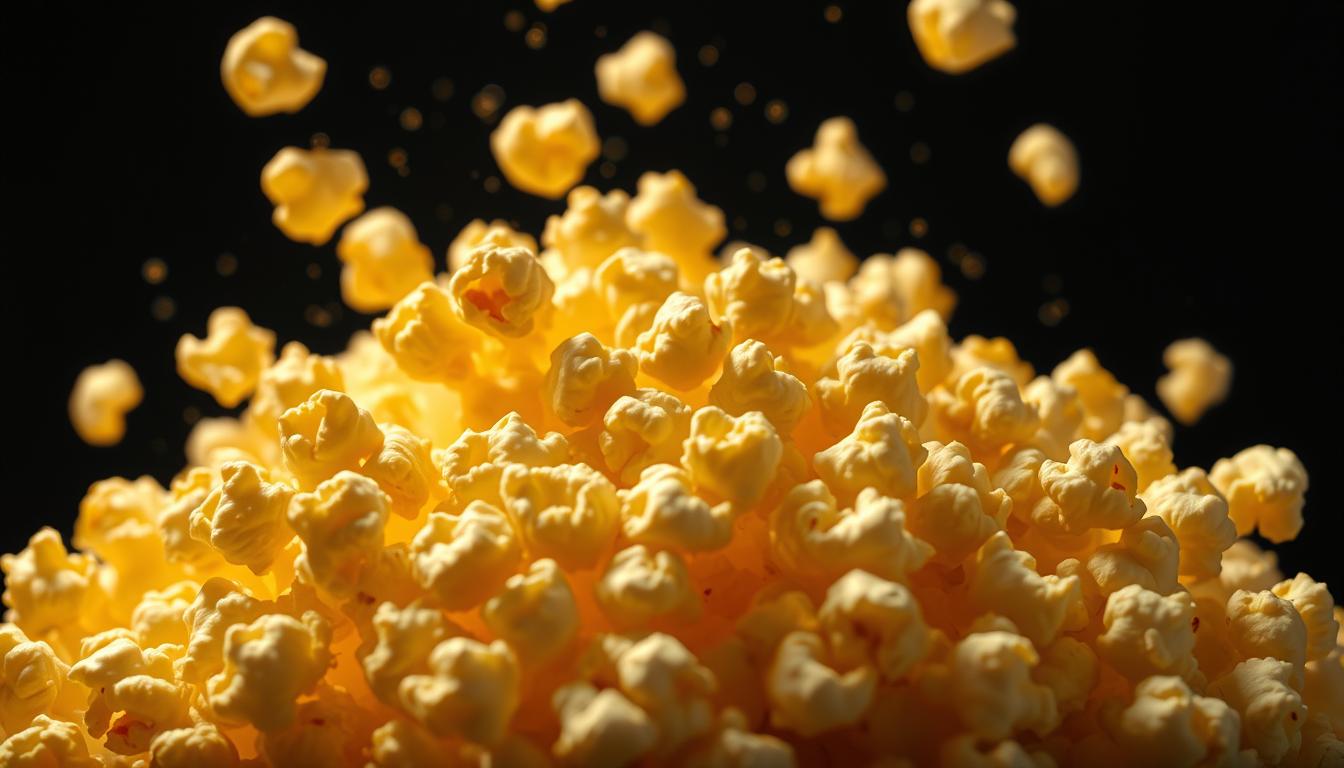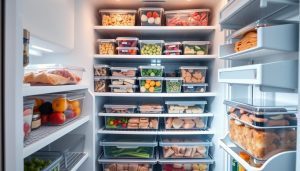Over 17 billion quarts of popcorn are consumed annually in the U.S., but only 34% of kernels fully transform into the fluffy snack we love. This snack’s magic lies in its unique structure: a moisture-sealed shell that turns into a mini pressure cooker when heated.
Each kernel contains a small droplet of water surrounded by starch. As heat builds, the droplet vaporizes, creating intense pressure. When the hull finally ruptures, the starch explodes outward—cooling instantly into the airy shape you recognize.
Not all kernels succeed. Those with cracks or low moisture content remain unpopped, often called “old maids.” Understanding this process helps you optimize preparation methods, whether using a stovetop, microwave, or specialized popper.
Key Takeaways
- Popcorn kernels require 13-14% internal moisture to build sufficient steam pressure.
- The starch expansion rate during popping can reach 40 times the kernel’s original size.
- Optimal popping occurs at temperatures between 350-400°F (177-204°C).
- Unpopped kernels often result from damaged hulls or improper heat distribution.
- Only one specific corn variety (Zea mays everta) can achieve this transformation.
Understanding the Science Behind Popcorn
That crunchy snack you love starts with a hidden water droplet trapped inside each kernel. Three elements work like clockwork: water becomes steam, steam builds pressure, and pressure triggers an edible explosion. Let’s break down how this trio turns dense kernels into airy bites.

The Role of Water, Steam, and Pressure
Every kernel houses a water reservoir at its core. When heated, this droplet vaporizes at 212°F—just like a whistling teapot. The steam can’t escape the airtight hull, so pressure climbs to 135 PSI. At 348°F, the hull cracks, releasing starch that cools into fluffy shapes.
| Temperature (°F) | Stage | Pressure (PSI) | Outcome |
|---|---|---|---|
| 212 | Steam Formation | 15 | Initial Pressure Build-Up |
| 348 | Critical Threshold | 135 | Hull Rupture |
| 400 | Optimal Popping | N/A | Maximum Expansion |
How Heat Transforms Kernels
Heat acts as the ignition switch. Without it, water stays dormant. Once temperatures cross 300°F, energy surges through the kernel. The outer shell conducts heat inward, creating a chain reaction. Starch gelatinizes, then inflates like a balloon when pressure drops.
Timing matters. Too little heat leaves unpopped kernels. Too much burns starch before expansion. Precision ensures that 14% moisture content converts to steam efficiently—no wasted snacks.
The Anatomy of a Popcorn Kernel
Every popcorn kernel operates like a natural pressure cooker, thanks to its precise internal design. Three layers work together to create that satisfying crunch: the endosperm, germ, and pericarp. Let’s dissect how these parts collaborate to turn heat into fluffy snacks.

Endosperm, Germ, and Pericarp Explained
The endosperm makes up most of the kernel’s interior. Packed with starch granules, it stores the moisture needed for popping. When heated, this starch transforms into the airy foam you recognize.
Nestled at the base, the germ is the kernel’s living core. It contains oils and proteins that contribute to flavor and nutrition. Even a damaged germ can prevent proper expansion during heating.
Surrounding both is the pericarp—a rigid cellulose shell. This layer acts as armor, trapping steam until pressure forces it to burst open. Without this barrier, kernels dry out and fail to pop.
| Component | Material | Key Role |
|---|---|---|
| Endosperm | Starch | Stores moisture for steam |
| Germ | Proteins & Oils | Adds flavor and nutrients |
| Pericarp | Cellulose | Creates pressure chamber |
The Crucial Function of the Hull
Often called the hull, the pericarp’s watertight seal is non-negotiable. Even microscopic cracks let steam escape early, leaving unpopped “old maids” in your bowl. Perfect hull integrity ensures pressure builds to 135 PSI before rupture.
You’ll notice quality kernels have smooth, unbroken hulls. These create the ideal environment for starch expansion. Damaged shells compromise the entire process, proving why proper storage and handling matter.
The Perfect Moisture Content for Popping
Ever wondered why some batches leave half your bowl unpopped? The answer lies in a precise balance you can’t see: internal moisture levels. Just 1% too high or low makes the difference between fluffy bites and disappointing duds.

Optimal 14-15% Moisture: Why It Matters
At 14% water content, kernels create enough steam to rupture their hulls. Below 13%, they lack the pressure to explode. Above 15%, excess moisture absorbs heat energy instead of building steam. Your fingernail reveals this balance:
| Moisture Level | Kernel State | Popping Result |
|---|---|---|
| <13% | Hard, no dent | Unpopped “old maids” |
| 14-15% | Firm but dentable | Full expansion |
| >15% | Soft, easy dent | Partial pops |
Commercial producers air-dry kernels to hit this sweet spot. Store yours in airtight containers to prevent humidity changes. Check freshness monthly using the dent test.
Proper storage maintains the delicate equilibrium. Glass jars outperform plastic bags, blocking moisture exchange. Remember: kernels aren’t shelf-stable forever. Rotate stock every 6 months for best results.
Optimal Temperature and Heat for Popping
Mastering the art of fluffy snacks requires precision heating. The journey from hard kernel to airy treat hinges on three thermal milestones: steam creation, pressure buildup, and explosive expansion. Each phase demands exact temperature control to maximize your success rate.

From Boiling Point to Explosive Temperatures
At 212°F, water inside the kernel vaporizes—your first critical checkpoint. This steam can’t escape the sealed hull, creating a pressure cooker effect. Heat must climb steadily to 348°F, where internal force exceeds the pericarp’s strength.
Rushing this process risks disaster. Rapid heating causes uneven steam distribution, leaving half-popped kernels. A gradual rise lets pressure develop uniformly. Commercial poppers maintain 356°F (180°C) for ideal results—hot enough to trigger expansion but below scorching thresholds.
| Stage | Temperature | Key Action |
|---|---|---|
| Phase 1 | 212°F | Steam generation begins |
| Phase 2 | 348°F | Hull rupture occurs |
| Phase 3 | 356°F | Maximum expansion achieved |
Your stovetop method needs similar discipline. Shake the pan constantly to distribute heat evenly. Electric poppers should preheat for 2 minutes before adding kernels. This mimics industrial conditions, giving every seed its best chance to transform.
Why Popcorn Pops: The Ultimate Guide
That familiar crackle in your bowl isn’t random noise—it’s physics in action. Researchers using high-speed cameras and acoustic sensors discovered the explosive sound originates from pressurized steam escaping ruptured kernels. As vapor bursts free, the hollow shape of the kernel amplifies vibrations like a miniature echo chamber.

“The ‘pop’ results from three coordinated events: hull fracture, starch expansion, and acoustic resonance—all occurring within 15 milliseconds.”
Here’s how it works: when internal pressure hits 135 PSI, the pericarp splits. Escaping steam forces starch outward, creating foam-like structures. Simultaneously, the kernel’s curved surface focuses sound waves, producing the sharp snap you hear.
| Stage | Action | Timeframe |
|---|---|---|
| Pressure Build-Up | Steam accumulates inside hull | 0-12 ms |
| Hull Rupture | Pericarp cracks under stress | 12-14 ms |
| Sound Generation | Steam release + shape resonance | 14-15 ms |
Failed kernels often lack this acoustic effect. Damaged hulls release steam too gradually, preventing the sudden pressure drop needed for loud pops. This explains why stale batches produce quieter results—their moisture-starved interiors can’t create explosive force.
Understanding these mechanics helps you appreciate the snack’s hidden complexity. Next time you hear that signature pop-pop-pop, you’ll recognize it as nature’s perfect blend of thermodynamics and acoustics.
Impact of Kernel Quality on Popping Performance
The fate of every kernel hinges on two invisible factors: structural perfection and precise moisture balance. Those stubborn unpopped pieces at the bottom of your bowl—often called Old Maids or Spinsters—reveal critical flaws in this equation. Their presence serves as a quality report card for your snack.

Understanding Un-popped Kernels: Old Maids and Spinsters
Damaged hulls act like leaky pressure valves. Microscopic cracks let moisture escape during heating, preventing steam buildup. Kernels with less than 13% moisture become hard and inflexible, while those over 15% turn soggy and unresponsive.
| Issue | Effect | Result |
|---|---|---|
| Hull Damage | Steam escapes early | No pressure for expansion |
| Low Moisture | Insufficient steam | Rigid, unpopped kernel |
| High Moisture | Delayed vaporization | Partial pops or burns |
Ensuring Kernel Integrity for Maximum Pop
Premium producers use optical sorting to eliminate flawed kernels. You can replicate this quality control:
- Inspect batches for smooth, unblemished hulls
- Store in airtight containers away from humidity
- Discard kernels that float in water (indicates cracks)
Once a hull fractures, no amount of reheating will fix it. The airtight seal can’t be restored, making proper storage non-negotiable. Glass jars outperform plastic by blocking moisture exchange more effectively.
Cultural and Historical Insights into Popcorn
Long before movie theaters and microwave bags, corn played a revolutionary role in ancient societies. Over 4,500 years ago, Mesoamerican farmers transformed wild grasses into the snack we recognize today through selective breeding. This innovation didn’t just create food—it shaped rituals and trade networks across early civilizations.
From Wild Grass to Global Phenomenon
Indigenous communities in modern-day Mexico mastered cultivation techniques that preserved the kernel’s unique popping ability. They identified plants with the toughest hulls and highest moisture retention—traits essential for creating steam pressure. These early agriculturalists unknowingly engineered the genetic blueprint for modern popcorn.
Archaeological evidence shows popped kernels in Peruvian caves dating back 6,700 years. This snack traveled along trade routes, reaching North American tribes centuries before European contact. Its durability made it ideal for storage, while its explosive transformation fascinated cultures worldwide.
Today’s global popularity stems from this ancient foundation. The journey from ceremonial use to food-related trivia staple highlights humanity’s enduring love for texture and simplicity. Next time you enjoy a bowl, remember you’re tasting a 4,500-year-old innovation perfected by generations of farmers.
Modern Innovations in Popcorn Production
Recent breakthroughs in agricultural practices are transforming how corn becomes your favorite snack. Over 90% of the world’s supply originates from America’s heartland, where farmers combine tradition with cutting-edge technology.
Smart Farming Meets Precision Processing
Soil sensors now monitor fields 24/7, ensuring optimal growing conditions. Hybrid seeds developed for thicker hulls and consistent moisture retention boost popping success rates by 18% compared to traditional varieties.
After harvest, infrared dryers replace sun-baking methods. These systems maintain exact 14.5% water content—critical for pressure buildup. Real-time sensors automatically adjust airflow, creating the perfect environment for future expansion.
Packaging innovations lock in freshness better than ever. Vacuum-sealed bags with moisture control layers keep kernels at peak condition for 24 months. This ensures every batch remains a reliable source of fluffy, fully expanded snacks.



